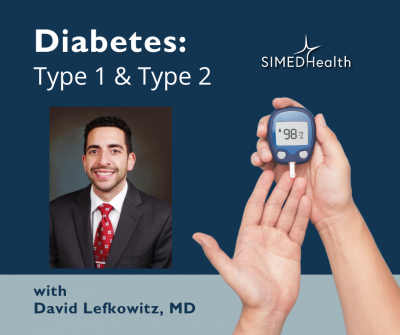
Type 1 & Type 2 Diabetes
Dr. David Lefkowitz, a SIMEDHealth Family Medicine physician explains the difference between Type 1 & Type 2 Diabetes.
To learn more about David Lefkowitz, MD, click here.
To make an appointment with SIMEDHealth Primary Care, click here.
1. What is the difference between type 1 and type 2 diabetes?
With Type 1 Diabetes, your body is unable to produce any insulin. Insulin is a hormone produced in the pancreas that allows blood sugar (glucose) to enter your body’s cells, where it is then metabolized for energy. Type 1 Diabetes can develop at any age, but is commonly diagnosed in children. At this time, there is no known way to prevent it.
Type 2 Diabetes occurs when the body starts to make less insulin AND cannot properly use the insulin it does make. Type 2 Diabetes can happen at any age, but is commonly diagnosed in adults. It is more common than Type 1, accounting for >90% of all diabetes cases. Type 2 diabetes can usually be prevented.
2. What are the signs and symptoms of diabetes?
Type 1 diabetes usually presents with rapid-onset of severe symptoms due to the quick, extreme build-up of glucose in the bloodstream. This leads to a condition called ketoacidosis which can cause weakness, confusion, abdominal pain, and severe thirst.
On the other hand, those with Type 2 Diabetes often have no symptoms in the early stages, which can last for years. Once it progresses, however, symptoms of high blood sugar can include increased thirst, increased urination, unexplained weight loss, and vision changes. Later symptoms of uncontrolled Diabetes are due to blood vessel and nerve damage which can lead to vision loss, kidney failure, non-healing wounds, painful diabetic neuropathy (nerve pain), infections, and limb loss.
3. What are the risk factors for type 2 diabetes?
Risk factors for Type 2 Diabetes include age over 45, having a history of a parent or sibling with diabetes, having fatty liver disease, having a history of gestational diabetes (diabetes during pregnancy), being of African American, Hispanic, American Indian, or Alaskan Native ethnicity, and obesity. Of these, obesity is the risk factor that is most modifiable, meaning you can improve it with healthier lifestyle habits.
4. How is diabetes diagnosed?
Type 1 Diabetes is usually diagnosed in an emergency room or their family’s doctor office after they present with symptoms of ketoacidosis (see above). A fingerstick or blood drawn lab will show extremely high blood sugar values.
Type 2 Diabetes is usually diagnosed on routine outpatient lab work showing higher than expected glucose results. We then typically look at two labs when we make a diabetes diagnosis:
-Fasting Plasma Glucose (FPG). This test is usually done early in the morning after an overnight fast, and checks your blood glucose value. A normal value is a FPG less than 100. An FPG of 101-125 is concerning for Pre-Diabetes, which may be a precursor to overt diabetes. Any FPG value 126 or higher is a sign of diabetes and should be confirmed with a repeat test. If there are two FPG tests at or above 126, the diagnosis of Type 2 Diabetes is confirmed.
-Hemoglobin A1c, or A1c for short. The A1c test reflects your average blood glucose level for the past 3 months. A normal A1c is less than 5.7. An A1c between 5.8-6.4 is concerning for Pre-Diabetes, which may be a precursor to overt diabetes. If there are two A1c tests at 6.5 or greater, the diagnosis of Type 2 Diabetes is confirmed.
5. What are the lifestyle modifications recommended to control diabetes?
Basically, it comes down to controlling weight via proper diet and physical activity. More specifically, the goal is for fat loss, without muscle loss. This is achieved by taking in adequate daily amounts of protein, decreasing total daily calories, and increasing physical activity/exercise.
The American Diabetes Association states you can lower your risk for Type 2 Diabetes by:
-Losing just 7% of your body weight (e.g.: 15 pounds if you weigh 200 pounds).
-Doing moderate physical activity (e.g. brisk walking) for 30 min a day, 5 days per week.
Getting proper sleep is also an important part of optimizing your lifestyle. Proper sleep is considered 8 hours of uninterrupted sleep per night. Also, patients who may have obstructive sleep apnea (those who briefly stop breathing, gasp, or snore during sleep) should be tested and, if necessary, treated.
6. What are the treatment options for diabetes?
There are many medicines used to treat diabetes, some old and some new. Older agents that have proven beneficial over the years include medications like metformin and glipizide. Newer agents include medications such as Januvia, Invokana, and Ozempic. These are but a few examples of medications that can be used. Doctors often start with older, more cost-effective medications and, if needed, additional agents may be added. Each agent treats high blood sugar in its own way, working in concert with the other medications the patient is taking.
Insulin shots are used when it is clear the body is not getting enough native insulin via the pancreas. Insulin is always the treatment for Type 1 Diabetes, and is sometimes needed to help treat Type 2 Diabetes.
Because obesity is such a strong risk factor for Type 2 Diabetes, lifestyle modification remains the very best treatment for these patients. In fact, sometimes improved eating habits and increased exercise is enough to treat Type 2 Diabetes without the need for medications. Genetics also plays a role and so your doctor will need to tailor your therapy specifically to you.
Your Primary Care physician or nurse practitioner is the best resource when it comes to questions about diabetes. We can screen you for blood sugar issues, diagnose them if they are present, and get you on the road to proper treatment to minimize your risks of developing complications like the ones listed above.